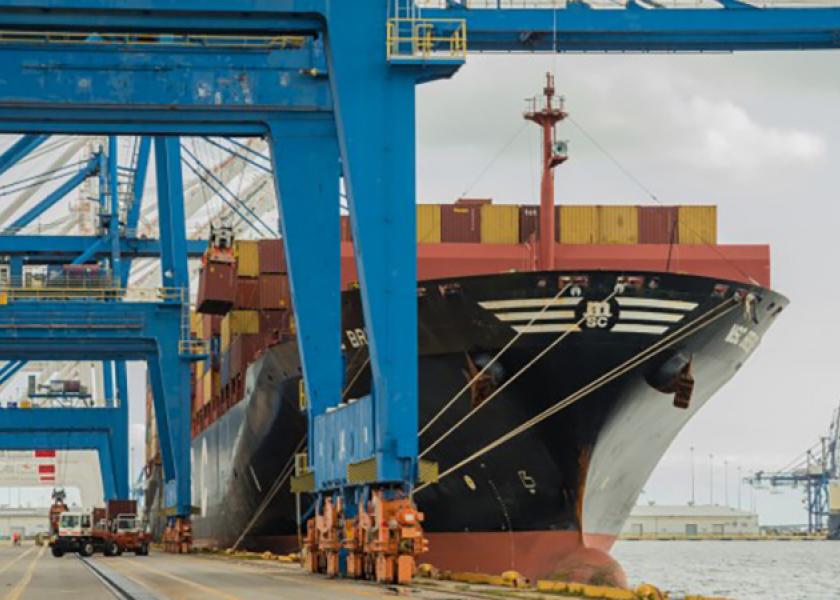U.S. Beef Exports Slightly Behind Last Year's Record Pace

August 2019 U.S. beef exports were below record-large totals of August 2018, according to data released by the USDA and compiled by the U.S. Meat Export Federation (USMEF).
Beef exports in August totaled 114,119 metric tons (mt), a 4% decline from 2018’s large volume, while export value was down 8% at $690.3 million. January-August beef exports were slightly below 2018’s record pace, declining 2% in volume to 881,526 mt and 1% in value at $5.44 billion. Value per head of fed slaughter averaged $298.94 in August, which is down 7% from a year ago, while the January-August average was down 3% to $309.85.
Exports accounted for 14% of total U.S. beef production in August, and 11.3% for muscle cuts only, down from 14.3% and 12.2% last year. In the first eight months of 2019, exports were 14.2% of total beef production and 11.6% for muscle cuts, down from 14.6% and 12.1% respectively in 2018, according to the USMEF report.
Following new value records in June and July, U.S. beef exports to South Korea slowed by 9% compared to a year ago, to 22,307 mt, while value dropped 11% to 157.4 million. However, for January-August, exports to Korea were still 8% ahead of 2018’s record pace in volume (17.290 mt) and 10% higher in value ($1.26 billion). Korean import data through August showed double-digit growth for U.S. beef in short rib and short plate/brisket. More than 55% of Korea’s chilled/frozen beef import volume came from the U.S., up from 53% in the first eight months of 2018.
Similar to pork, the U.S. beef industry looks forward to gaining tariff relief in leading market Japan, where August exports slipped 15% from a year ago to 28,646 mt, according to USMEF. Value was down 22% to $164.3 million, though the group notes that exports in August 2018 were a post-BSE record $209.3 million. January-August, exports to Japan were 3% below last year’s pace in volume, 217,698 mt, and 4% lower in value, $1.36 billion.
Beef variety meat exports (mainly tongues and skirts) to Japan have been a bright spot in 2019, increasing 31% in volume and 18% in value. U.S. tongues and skirts have higher duty rates than competitors’ products but are tariffed at 12.8% compared to 38.5% for U.S. muscle cuts.
“The U.S. beef industry is extremely excited at the prospect of lower tariffs in Japan, as 38.5% is the highest rate assessed in any major market,” said Dan Halstrom, president and CEO of USMEF. “As we’ve seen in Korea, where the tariff rate was once 40% but has been reduced by more than half, lower tariffs make U.S. beef even more affordable for a wider range of customers. While the agreement still needs parliamentary approval in Japan, importers are already enthused and preparing for long-awaited tariff relief.”
Beef exports to China/Hong Kong fell 24% in August from a year ago in volume, 60,259 mt, and 20% in value, $510.7 million. Several factors have impacted the U.S. exports to the region, the USMEF report notes, including street protests in Hong Kong that have slowed commerce and tourism. Though supermarket sales are strong in Hong Kong, the disruption has been hard on the restaurant sector.
China is still a small destination for U.S. beef and although exports are hampered by retaliatory duties, January-August volume increased 23% from 2018 to 5,625 mt, valued at $44.7 million, which is an increase of 12%.
January-August highlights for U.S. beef include:
- Exports to Mexico, the third-largest international market for U.S. beef, were slightly lower than a year ago in volume (156,528 mt, down 1%), but value increased 5% to $729.5 million. Beef variety meat exports to Mexico were down 3% from a year ago to 62,504 mt, but commanded better prices as export value increased 12% to $166 million.
- Although beef exports to Taiwan were modestly lower year-over-year in August, January-August exports were still 10% percent above last year’s record pace in volume (42,785 mt) and 7% higher in value ($383.9 million).
- Led by surging demand in Indonesia and solid growth in the Philippines and Vietnam, beef exports to the ASEAN region were 27% above last year’s pace in volume (37,206 mt) and 12% higher in value ($180.6 million).
- Strong August results in Central America pushed exports 4% above last year’s pace in volume (9,898 mt) and 10% higher in value ($56.7 million), led by a strong performance in Panama and steady growth in Guatemala and Honduras.
- Beef exports to the Dominican Republic continue to reach new heights, as volume increased 45% from a year ago to 6,060 mt, while value climbed 35% to $48.6 million.
Related stories:







